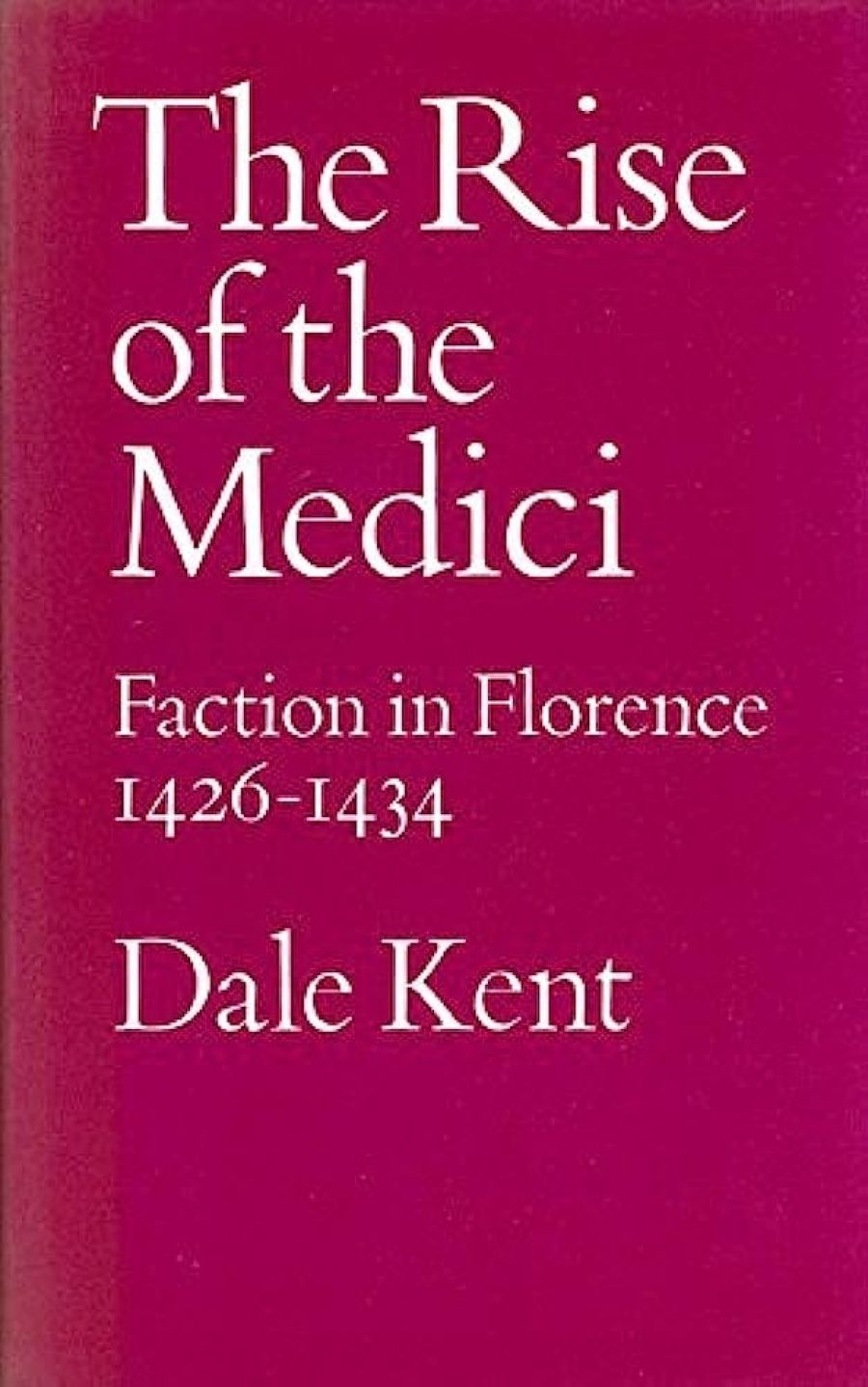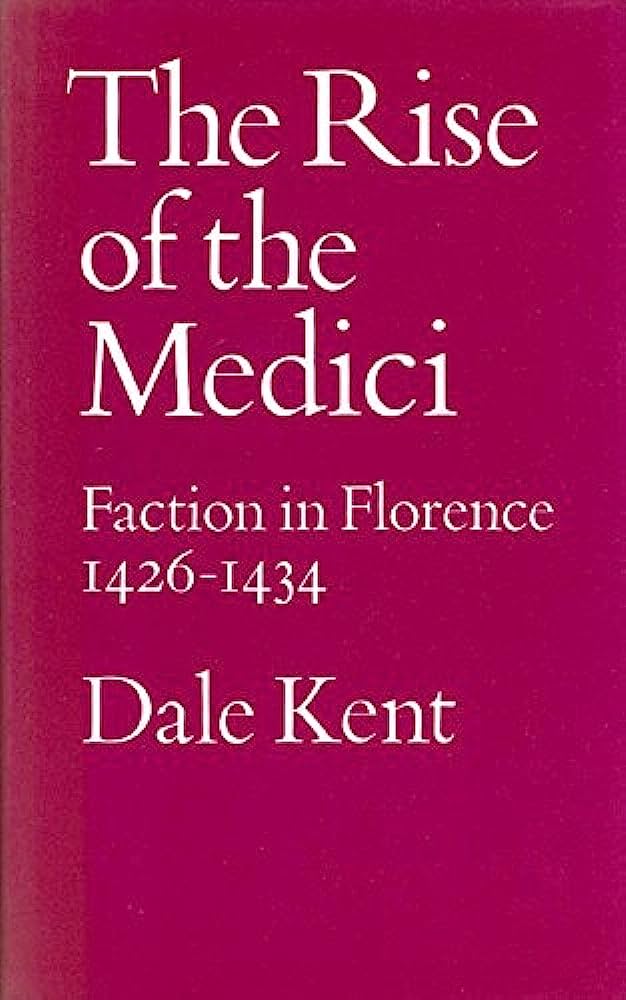
- Free Article: No
- Contents Category: History
- Review Article: Yes
- Article Title: Politics in a City
- Online Only: No
- Custom Highlight Text:
Few families in Italian history have enjoyed a fame greater than the Medici whose name has become inseparably linked with the Renaissance. It is paradoxical, therefore, how little has really been known, until recently, of how Cosimo, the founder of its predominance in Florence, paved the way for the establishment of the power it was to exercise over that city. Nicolai Rubinstein, some years ago in his Government of Florence under the Medici, showed how its ascendancy was maintained through a complex system of electoral controls, but it is only now, with the appearance of Australian historian Dale Kent’s study, The Rise of the Medici, that a clear picture is beginning to emerge of the process by which the Medici first issued from the ranks of the Florentine ruling class to the position of dominance which they gradually consolidated over the six decades following Cosimo’s triumphant return from exile in 1434.
- Book 1 Title: The Rise of the Medici
- Book 1 Subtitle: Faction in Florence 1426–1434
- Book 1 Biblio: Oxford University press, $40 hb, 389 pp
- Book 1 Cover Small (400 x 600):

- Book 1 Cover (800 x 1200):

The reason why we have had to wait so long for an accurate account of the transition from the previous aristocratic regime of the Albizzi to the inauguration of the Medici system lies essentially in the nature of the available sources. Nineteenth-century historians’ knowledge of this period depended largely on chronicle evidence and therefore reflected the biases and distortions of contemporary writers such as Giovanni Calvacanti. Later, the examination of archival material, such as, for instance, the records of the deliberations of the executive and consultative assemblies of the Florentine government used recently by Gene Brucker for his Civic World of Early Renaissance Florence, filled out and corrected the narratives of earlier authors with more precise and reliable information on how and why key decisions were made.
Dale Kent has now gone beyond this level of explanation through the discernment of motivation to an exposure of the underlying texture of the political society out of which events flowed. Her sources have been the letters and other documents revealing the patron and client relationships, factional allegiances and party groupings of the various sections of the Florentine ruling class. Although the time span of her study is short – the mere eight years leading up to the Medici takeover of 1434 – she has therefore been able to arrive at a picture in depth of the social substructure on which the city’s government rested and from shifts in which changes in its character issued.
Kent’s story begins with the year 1426, when the then dominant ‘oligarchy’ had already begun to feel itself under threat. She shows how, from that time onwards, the Medici party extended its already considerable influence through family connections, marriage alliances, the financial ramifications of the Medici bank, and the careful cultivations of ‘friends’ – that is to say clients to whom favors were promised or given in return for loyalty. Kent’s analysis confirms that, while the leaders of the faction were solidly aristocratic, it did appeal, more than the rival one of the Albizzi, to ‘new men’ and people of more modest social status. By contrast, the opponents of the Medici came, with rare exceptions, from old established houses, spread fairly evenly around the city rather than concentrated (as the Medici were) predominantly in one quarter, and linked by a tradition of active service in government since the establishment of the Albizzian ascendancy late in the fourteenth century. Side by side with these two political alignments, the former already quite tightly organised, the latter much looser, there were, however, as this detailed and intricate study reveals, other uncommitted families whose role was to be crucial in the gradual shift in the allegiance of the majority of the Florentine governing elite from Rinaldo degli Albizzi to Cosimo de’ Medici.
The key to this development lay in the events of the years 1426–34, particularly in the impact of the disastrous Florentine war with Lucca of 1429–33. It was this which, more than anything else, discredited Rinaldo degli Albizzi and forced him to the desperate expedient of exploiting a majority by his partisans in the Signoria of May–June 1433 to exile the leaders of the Medici faction. From Kent’s reconstruction of the state of the parties by this time, it is evident that these banishments and the electoral ‘reforms’ which followed them neither eliminated the underlying bases of Medici support, nor prevented the defection of some leading families, formerly neutral or sympathetic to the old order, to the side of the exiled Cosimo. The result was that, a year after his expulsion from the city, a majority in the Signoria, now in his favour, brought about his return, and set to train the measures that were to result in the condemnation, in their turn, of his enemies.
What emerges most clearly from Kent’s masterly account of these events, is the fluidity of the Florentine political alignments of the period, within the context of a basically stable system. In this, clusters of great families, each underpinned by its network of patronage, made or unmade ruling factions as the balance of power and wealth in the city altered, but, with the exception of the leaders of the losing clique, retained their influence by trading their support for a place in the new reggimento. At the same time, her analysis of the Medici party also reveals that, in the tight organisation and coherence which it developed while a vulnerable out-group, it introduced something new into Florentine politics – the capacity to hold the loyalty of its members even when, in order to consolidate its authority through electoral controls, it infringed political practices which the Albizzi had hesitated to violate.
The thoroughness with which the conclusions of this work are demonstrated by reference to the full body of available evidence make of it a landmark in the historical literature on the early Medici. In it, that family’s rise to power is illuminated in all the fineness of detail. It is testimony to the corning of age of Italian Renaissance studies in Australia that a book of this quality, in the mainstream and forefront of international scholarship in the field, has been produced in this country.
If this excellent example of historical research has a limitation, it is that inherent in any specialised, intensive examination of a restricted period. While it demonstrates admirably how the Medici rose to power, it does not really answer the question why the previous regime had become so weakened as to be easily overthrown. As this book itself shows, by 1426, the starting point of Kent’s inquiry, the old ruling group was already in decline, so that, in order satisfactorily to explain its demise and its replacement by the faction centred on the Medici, one would need to go back in time to find the further causes of its faltering authority. There are hints to some of these in this study in references, for instance, to the deaths between 1417 and 1432, of the generation of outstanding men who had led the so-called Albizzian ‘oligarchy’ in its heyday. But the underlying reasons why the sons of these patricians found it so much more difficult to maintain the ascendancy enjoyed by their fathers clearly need to be determined – perhaps by attempting, for the immediately preceding period, just such an exhaustive and perceptive exploration of the sources as Dale Kent has undertaken in her book for the years 1426–34.


Comments powered by CComment